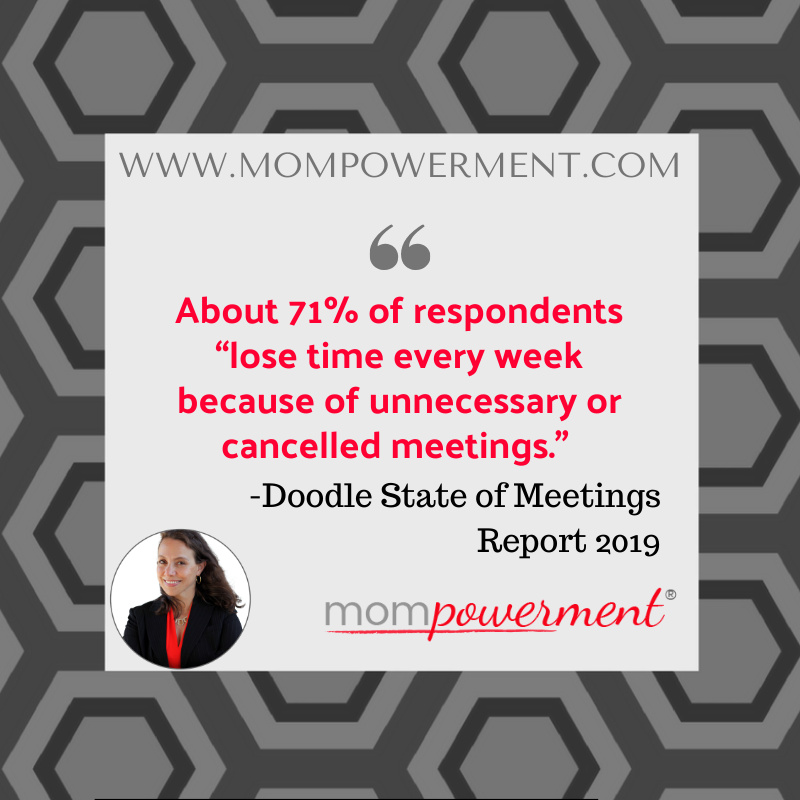
So many meetings! What choice do you have outside of working late or taking work home to finish up once kids are in bed when you’re in meetings back to back. What if you could have more efficient and effective meetings? It’s possible. We’ll dig in to see how you can maximize meeting time.
Meetings impact work-life balance
Why talk about meetings on a blog about work-life balance? It’s simple. How are you supposed to find more time with your family or do all the other things you want to do when you’re in meetings all day? I’m sharing ideas on making meetings more effective and efficient so you have time for work. And that often means less work at home and fewer late nights, which can lead to more time for all the other stuff in life.
And, another thing to consider. Those poorly organized meetings can help you slow down a project’s progress or have you head down the wrong path because of a tangent. And that doesn’t help anyone’s work-life balance. Just more reasons to have meeting be more effective.
Meetings overload is common
Are meetings are keeping you from getting your work done? You’re not alone. About 44 percent of people who attend a poorly organized meeting feel that “[they] don’t have enough time to do the rest of [their] work.”1
If you’re reading this as a leader or business owner, consider that the cost of poorly run meetings in the US alone is more than $399B per year.1 Yes, you read that right. That billion with a “B.” So, consider the financial cost on top of the time issue from meetings not working for us.
Does the meeting have to happen?
First off, let’s talk about the number of meetings we have that don’t need to happen. Are you better served with an in-person, video, or phone conversation between two people? Can this be done with a simple email exchange? Avoiding unnecessary meetings makes everyone’s productivity and time management improve as they can actually find time to do work.
Strategically use email
What if you could have an email exchange instead of a phone call or meeting? The rule of thumb I’ve always heard is that if it takes 3 or fewer emails, do it via email and be done with it. You can always share the results of the email exchange to the extended team. And, instead of using that time in a meeting, people could use that time to actually work on the next steps post-discussion between the two people who really needed to talk.
Email should be concise and organized. This isn’t the time to write a novel. And, if there is a lot of information you need to share, perhaps you need to consider another format like a white paper.
The way people know if they need to do something or simply know what’s going on is the difference between To, CC, and even BCC. If someone is BCC’d, let people know. Or move people to BCC when you’re simply saying thank you and taking the next step, but that person doesn’t need to deal with anymore back and forth. Tell people you’re doing that, though. I will sometimes say literally, “I’m moving John to BCC so that he won’t deal with any more of our back and forth.”
When it comes to writing email, ensure that you’re being effective and strategic with your communication. Use bullets to help people skim email because it’s likely what the recipient will do. Consider subheadings as needed if you’re covering different types of information.
Keep in mind what the recipient(s) need to know to take whatever action is necessary. It’s not only about what you want to share.
Whether you work for an employer or you’re a solopreneur or anything in between, consider creating templates to help you be more efficient and effective with your email communication.
Maximize meeting time
Know the objective of the meeting. You’ve used your mastery of email and understanding of when to have meetings and you realize you need to have a meeting with a small group. That’s fine. Make sure you understand the objective because that impacts what you’ll cover and who needs to attend. Invite only those who are necessary. Anyone else can see outcomes in the meeting notes (more on that shortly).
Consider the length of the meeting. There is a reason that TED talks are 18 minutes or less. People’s ability to focus is limited. It’s the nature of the human brain and body. Considering what the topic is, what is the least amount of time you can possibly use to cover the topic at hand? You don’t have to use up the 30-minute session on your calendar. It could be as short as 15 (or maybe even 10) minutes. Yep, 15 minutes. And people will appreciate it.
Share what works. Take this information and share it across the company. You want everyone to have more effective meetings. It only increases productivity and time management across the company. And, yes, that means the company becomes more balance friendly. What company doesn’t want to empower employees to create greater balance?
Before the meeting
Send out an agenda ahead of time. Your agenda should support whatever the objective is and clearly show why participants need to attend. I prefer to include information on timing with the agenda, especially if senior leaders may join to cover specific topics. If for some reason someone can only be there for a short time, let him/her know when he/she is most needed. This can especially be the case when you’re engaging senior team members.
Give homework ahead of time. Unless you’re launching a topic, you want to be able to take action during the meeting. The meeting is often time for active discussion and creating solutions. That means people likely need to do some kind of homework. Yes, homework. Think about it this way…What do you need attendees to do before the meeting so that you maximize your time together.
Do pre-meeting conversations as necessary. If you’re asking people to present something or share information as part of the meeting or a participant might be surprised by the request for him/her to attend, have a conversation ahead of time. Be as specific as you can to ensure people do what’s necessary so you can accomplish your objective(s) during the meeting.
During the meeting
During the meeting, there are a few ways that you can have an organized meeting that allows for all participants to maximize their time. We’ll cover a few of those tips here.
Be respectful of people’s time. Start and end on time. Remember, attendees could be doing all sorts of things instead of being at your meeting. Don’t be afraid to table topics in a parking lot of sorts if related topics come up and you don’t need to cover during the meeting.
Engage all participants. While you’re having the discussion during the meeting, ensure that everyone who attends can share his/her thoughts. You invited these attendees for a reason, so make sure each is heard.
Consider remote employees. If you have remote workers participate, make sure they feel engaged and heard. If necessary, explain to the remote attendees what’s happening in the room and get their feedback. Let’s face it, it’s easier to follow the discussion in-person. And summarize any topics before you move on. Make sure any remote participants get copies of any documents you’ll cover in the meeting, even if they’re sent out as the meeting starts.
Follow the agenda. Remember that you’re there to take action, based on the objective(s) of the meeting. Follow the agenda and table any unnecessary conversations. A parking lot for unrelated topics can be helpful. Make sure the sidebar conversations don’t happen because they’re likely not getting you any closer to your agenda items. And, if they are, summarize them and include them in the meeting notes.

After the meeting
You’ve had the discussion and taken action. Great! You’re done, right? Not so fast. You want to summarize the meeting and make sure the remote attendees understand as well. And ensure that you know next steps, including who’s assigned to do them. This is either homework post- meeting or homework for the next meeting. Either way, people need to know what’s expected of them.
Meeting notes sometimes feel like a think of the past. They are important, though. Write up what happened during the meeting, including discussion and action. And send it out the attendees and anyone who didn’t attend who would benefit from knowing about the meeting and next steps. This is a great time to include your manager or your project management team.
A few final tips
- Give people advanced notice if a meeting is cancelled. If someone is getting back time in his/her day, let that be known ahead of time so he/she can be productive. You’d appreciate that notice, right?
- Consider ending your meetings 5 minutes early. Yes, end 5 minutes before the meeting officially ends to account for so many having back to back meetings. Essentially, your 30-minute meeting is actually 25 minutes long.2
- Have a timekeeper. Especially if you have an agenda that includes timing, have someone keep an eye on time and essentially keep the agenda moving forward. That way one topic doesn’t dominate the meeting when you have a few topics to cover during the meeting time.
- Keep a parking lot of topics you need to discuss later. It’s OK if someone brings up something that is tangentially related to the topic at hand. Put it on the parking lot and discuss in-person or via email at a later time.
- Limit non-essential tech usage. Try to get people to not actively be on their phones during the meeting. I’ve seen others ask attendees to check-in their phones, which I’m not comfortable with. I keep my phone nearby in case my boys’ school calls, but I turn the phone face down so I’m not looking at the screen. You can ask people to do this. Seems like a compromise between stepping away from technology and still haven’t it nearby.
See something in this article that you’re going to try as part of your efforts to maximize meeting time? What do you do to make your meetings more efficient? I’d love to know what’s working or what you’re struggling with. Feel free to comment or shoot me an email.
Looking for other ways to be more productive? The Mompowerment books are full of practical tips and ideas on maximizing your time. Grab your copy of The Mompowerment Guide to Work-life Balance on Amazon today (affiliate link).
1 https://meeting-report.com/personal-impact-of-meetings/0
2 https://meetingking.com/how-long-should-a-meeting-be/


